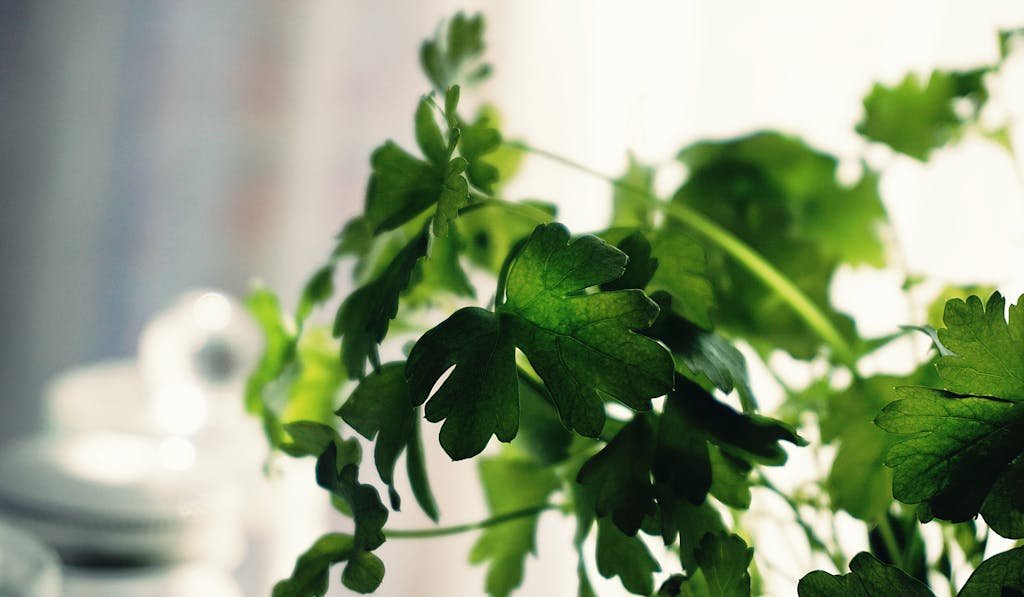Parsley – Petroselinum (crispum)
Parsley, a humble herb often sprinkled on dishes for a pop of color, is more than just a garnish. With varieties like Petroselinum crispum, Petroselinum neapolitanum, and Petroselinum tuberosum, it’s a versatile plant that’s found its way into kitchens and medicine cabinets around the world. Rich in flavor and packed with nutrients, parsley has been celebrated for its health benefits and culinary uses for centuries.
From the curly leaves of Petroselinum crispum to the flat, Italian leaves of Petroselinum neapolitanum, and the lesser-known root variety, Petroselinum tuberosum, each type brings its unique qualities to the table. Whether it’s jazzing up a salad, enriching a soup, or supporting digestion, parsley’s role in food and wellness is undeniable. Let’s dive into the world of parsley and discover its secrets.
Key Takeaways
- Parsley Is Nutritionally Dense: Offering an abundance of vitamins A, C, and K, plus minerals, parsley supports overall health including bone health, immune system, and anti-inflammatory effects, demonstrating it’s much more than a garnish.
- Culinary Flexibility of Parsley: With varieties such as Petroselinum crispum (curly leaf), Petroselinum neapolitanum (flat-leaf), and Petroselinum tuberosum (root parsley), the herb brings unique flavors and textures to a wide range of dishes, from soups and salads to beverages.
- Health Benefits Beyond the Kitchen: Parsley is celebrated for its diuretic properties, aiding in kidney function and potentially lowering blood pressure. It’s also recognized for antioxidant properties that combat oxidative stress, potentially reducing the risk of chronic diseases.
- Easy to Cultivate and Use: Parsley is accessible for both seasoned gardeners and novices, thriving in various climates with minimal care. Its versatility extends to its preparation, easily incorporated fresh or dried into meals and drinks for a nutritional boost.
- Improves Digestive Health: Incorporating parsley in meals can stimulate digestion and alleviate bloating, thanks to its carminative properties, making it beneficial for gut health.
- Supports Heart and Joint Health: High in folate, parsley helps maintain low homocysteine levels, reducing the risk of heart diseases. Its eugenol content offers anti-inflammatory benefits, which may alleviate arthritis symptoms.
The Versatile Herb: Parsley
Parsley (Petroselinum crispum, Petroselinum neapolitanum, Petroselinum tuberosum) stands out as not just an herb but a multi-functional wonder in both the kitchen and medicinal world. Its vibrant green leaves are more than just a garnish on the plate; they are packed with a plethora of nutrients making parsley a go-to for those looking to boost their health through food.
Nutritional Value and Health Benefits
Parsley is rich in vitamins A, C, and K, offering a range of health benefits from improving bone health to providing antioxidant properties. Its high vitamin C content not only supports the immune system but also acts as an anti-inflammatory agent, vital for combating various health issues. Studies have shown that the flavonoids in parsley, such as luteolin, have the potential to reduce the risk of diseases by fighting off free radicals in the body.
| Nutrient | Amount per 100g |
|---|---|
| Vitamin A | 421 µg |
| Vitamin C | 133 mg |
| Vitamin K | 1640 µg |
Culinary Uses of Parsley
In the culinary world, parsley is incredibly versatile. It seamlessly blends into a variety of dishes, ranging from sauces and soups to marinades and salads. Curly leaf parsley (Petroselinum crispum) and flat-leaf parsley (Petroselinum neapolitanum) each bring a distinct taste; the former offers a mild, grassy flavor, while the latter boasts a more robust and peppery note. This versatility means parsley can enhance a wide array of recipes, adding depth and vibrancy to dishes.
Moreover, parsley’s role in traditional and modern cooking transcends mere flavor enhancement. It’s also traditionally used to aid digestion. Incorporating parsley into meals can help stimulate digestion and alleviate bloating, making it a beneficial herb for overall gut health.
In essence, parsley’s diverse applications in both culinary and medicinal contexts underscore its invaluable contribution to a healthy lifestyle. Whether it’s being used to perk up a dish or as part of a health regimen, parsley proves to be an essential herb in any kitchen or garden.
Varieties of Parsley
Parsley, a culinary and medicinal herb, has various types each with its distinct features and uses. Petroselinum crispum, Petroselinum neapolitanum, and Petroselinum tuberosum stand out as the primary varieties, each bringing something unique to the table.
Petroselinum crispum, commonly known as curly parsley, is characterized by its bright green, curly leaves. It’s not just a garnish; its vibrant taste is a great addition to soups, stews, and salads. Curly parsley is rich in vitamins and minerals, making it a nutritious addition to any diet.
Moving onto Petroselinum neapolitanum, also known as flat-leaf parsley, it differs from its curly counterpart with its smooth, flat leaves. This variety is heralded for its robust flavor, making it a favorite among chefs for cooking. Flat-leaf parsley is often used in Italian and Middle Eastern cuisines, where its bold taste can truly shine.
Lastly, Petroselinum tuberosum, known as Hamburg or turnip-rooted parsley, is unique for its edible root, similar to a parsnip. This variety is less known but highly versatile, offering both flavorful leaves and a root that can be cooked or eaten raw.
Each variety of parsley not only brings its distinctive taste and texture to the table but also boasts a range of health benefits. From improving bone health to providing antioxidant properties, parsley is more than just a green garnish. It’s a powerhouse of nutrition, offering vitamins A, C, and K among other nutrients.
While these varieties have their specific culinary uses, they also share common health benefits. Studies have shown that consuming parsley can aid digestion and promote gut health. It’s no wonder that parsley finds its way into kitchens and gardens around the world, showcasing its adaptability and benefits in various dishes and medicinal uses.
Petroselinum crispum: The Curly Leaf Parsley
Petroselinum crispum, commonly known as curly leaf parsley, is a bright green, biennial plant in temperate climates but often treated as an annual in subtropical and tropical regions. This versatile herb is not only a familiar garnish but also a powerhouse of nutrients, rich in vitamins A, C, and K, which are essential for maintaining optimal health.
Curly leaf parsley features vibrant, ruffled leaves that distinguish it from its flat-leaf counterpart, Petroselinum neapolitanum. Despite its decorative appearance, it’s not merely for garnishing dishes. It’s a flavorful addition to soups, salads, and sauces, offering a slightly peppery taste with a hint of earthiness that enhances the overall flavor profile of any dish it accompanies.
Research has shown that Petroselinum crispum possesses antioxidant properties, which can play a crucial role in combating oxidative stress, a factor linked to chronic diseases such as heart disease and cancer. A study published in the Journal of Agricultural and Food Chemistry highlights its potential in promoting health and preventing disease through its high content of flavonoids, compounds known for their antioxidant abilities.
Moreover, curly leaf parsley serves as a natural diuretic, aiding in fluid balance and supporting kidney function. This makes it a valuable herb for those looking to manage blood pressure and improve urinary tract health. Its role in supporting digestion cannot be overstated, as it helps in stimulating the appetite and soothing the digestive tract, making it a smart choice for those aiming to enhance their digestive health.
The cultivation of Petroselinum crispum is straightforward, thriving in well-drained soil with full to partial sunlight. Gardeners and chefs alike prize this herb for its ease of growth and its culinary versatility, making it a staple in kitchen gardens and meal preparations worldwide. Whether used fresh or dried, curly leaf parsley is a key ingredient in a multitude of recipes, from traditional Middle Eastern tabbouleh to Italian salsa verde.
Its inclusion in diets is encouraged not just for its flavor but also for its health benefits. Given its nutritional profile, incorporating curly leaf parsley into meals is a simple yet effective way to elevate both the taste and nutritional value of foods.
Petroselinum neapolitanum: The Italian Flat Leaf Parsley
While Petroselinum crispum garners attention for its curly leaves, Petroselinum neapolitanum, known as Italian flat leaf parsley, holds its ground with a bold flavor profile and versatile culinary applications. Distinct from its curly counterpart, flat leaf parsley possesses a smoother texture and a more robust flavor, making it a preferred choice in various Italian and Mediterranean dishes.
Italian flat leaf parsley is not only celebrated for its culinary uses but also for its nutritional benefits. It is rich in vitamins A, C, and K and minerals like iron and potassium, contributing to a balanced diet. The presence of these nutrients aids in bolstering the immune system, improving vision, and promoting heart health.
Research into the health benefits of flat leaf parsley reveals its potent antioxidant properties, primarily attributed to its high flavonoid content. These antioxidants play a crucial role in combating oxidative stress, thereby potentially reducing the risk of chronic diseases. Additionally, studies have highlighted its anti-inflammatory effects, further reinforcing its position as a health-boosting herb.
Beyond health, Petroselinum neapolitanum also offers practical gardening benefits. It thrives in a range of climates and requires minimal care, making it an accessible plant for novice and experienced gardeners alike. The herb’s adaptability and low maintenance needs contribute to its popularity in home gardens.
Culinary experts and home cooks often incorporate Italian flat leaf parsley into sauces, pesto, and dressings for its vibrant color and depth of flavor. Its leaves are larger and more resilient than those of curly parsley, allowing them to withstand cooking better and making them an excellent choice for hot dishes.
Italian flat leaf parsley’s contribution to cuisine, health, and gardening illustrates its multidimensional value. Whether used to enhance the flavor of a dish, contribute to a nutritious diet, or adorn a garden, Petroselinum neapolitanum stands out as a versatile and beneficial herb.
Petroselinum tuberosum: The Root Parsley
Shifting focus to a less commonly known variety, Petroselinum tuberosum, or root parsley, is celebrated for its versatile root rather than its leaves. Unlike its counterparts, this variety prioritizes the growth of a substantial, parsnip-like root. Cultivated extensively in central and eastern Europe, it’s a key ingredient in soups, stews, and as a ground spice after drying and grinding.
Nutritional Profile and Health Benefits
Root parsley is not just a flavor enhancer; it’s packed with nutritional benefits. Loaded with vitamins A, C, E, and B-complex, as well as minerals like iron, calcium, and magnesium, it’s a powerhouse of nutrients. Researchers have delved deep into its health contributions, finding it to possess diuretic properties that can aid kidney function and hypertension management.
| Nutrient | Amount per 100g |
|---|---|
| Vitamin A | 505 IU |
| Vitamin C | 133 mg |
| Iron | 6.2 mg |
| Calcium | 85 mg |
Cultivation and Harvest
Growing Petroselinum tuberosum requires patience as it has a longer maturation period compared to leaf parsleys. However, its resilience to cold and preference for deep, rich soil make it a fitting crop for gardeners seeking a rewarding challenge. Harvesting typically occurs when the root reaches a usable size, often resembling a slender parsnip.
Culinary Uses
In the kitchen, root parsley stands out for its distinctive taste, described as a blend of celery, carrot, and parsley. It’s a staple in Eastern European cuisine, providing a unique flavor and texture to dishes. Its robustness makes it ideal for long-cooking recipes, where it imparts a subtle, yet unmistakable earthiness.
As food enthusiasts and nutritionists continue to discover and share the myriad benefits and uses of Petroselinum tuberosum, it’s clear this variety of parsley is more than just an underground treasure. With its nutritional benefits, culinary versatility, and ease of cultivation, root parsley is steadily carving its niche in gardens and kitchens around the world.
Culinary Uses of Parsley
Parsley, a versatile herb found in kitchens worldwide, plays a crucial role in numerous culinary traditions across various continents. Petroselinum crispum and Petroselinum neapolitanum, commonly known as flat-leaf or Italian parsley, along with Petroselinum tuberosum, also referred to as root parsley, collectively contribute to the herb’s prominence in the culinary world.
In Mediterranean cuisine, parsley is not just a garnish; it’s an integral ingredient. It provides a fresh, vibrant flavor to dishes such as tabbouleh, a Levantine salad where parsley is the star, finely chopped and mixed with bulgur wheat, tomatoes, onions, and mint. Italian cooking incorporates parsley into pesto sauces, replacing or mixed with the traditional basil to introduce a different flavor profile.
Beyond fresh uses, parsley’s applications in cooked dishes are equally important. Petroselinum tuberosum, with its substantial root, is a favorite in Eastern European and Mediterranean stews and soups. Its unique taste, a blend of celery, carrot, and traditional parsley flavors, adds depth and complexity to warm dishes.
Parsley in Beverages
Parsley’s versatility extends into beverages where it’s used for its health benefits and fresh taste. Parsley tea, for instance, is brewed for its diuretic properties and as a remedy for kidney function and hypertension management. Smoothies and juices often include parsley for an extra vitamin punch, taking advantage of its high vitamin A, C, and E content.
Storage and Preparation Tips
To maximize parsley’s life and flavor:
- Store fresh parsley in the refrigerator wrapped in a paper towel and placed in a bag.
- Wash it thoroughly under cold water to remove any soil or sand before using.
- For root parsley, peeling is not necessary, but scrubbing it clean is recommended to remove any residual earth.
Parsley, with its health benefits, adaptable flavor profile, and culinary versatility, continues to be a staple herb in global cuisines. Its easy cultivation makes it accessible for home cooks and professional chefs alike, ensuring its popularity remains unwavering in kitchens around the world.
Health Benefits of Parsley
Parsley, known scientifically as Petroselinum crispum, Petroselinum neapolitanum, and Petroselinum tuberosum, isn’t just a garnish on the plate; it’s a powerhouse of nutrients offering numerous health benefits. This section delves into why incorporating parsley into one’s diet can be a game-changer for overall health.
Firstly, parsley is rich in vitamins A, C, and K, essential for maintaining optimal health. Vitamin A supports eye health and immunity, while vitamin C plays a crucial role in the synthesis of collagen, aiding in skin, bone, and joint health. Vitamin K is vital for blood clotting and bone metabolism. The herb’s high antioxidant content, including flavonoids and vitamin C, helps combat free radicals, reducing oxidative stress and potentially lowering the risk of chronic diseases.
Furthermore, parsley has been recognized for its diuretic properties, which can support kidney function by promoting increased urine production. This helps in flushing out excess fluids and toxins from the body, enhancing kidney health. Research studies suggest that myristicin, a compound found in parsley, may also have diuretic effects which can be beneficial for those with kidney stones or urinary tract infections.
| Nutrient | Content per 100g |
|---|---|
| Vitamin A | 421 μg |
| Vitamin C | 133 mg |
| Vitamin K | 1640 μg |
| Myristicin | Not specified |
Another significant health benefit of parsley is its potential to support heart health. Its high levels of folate—a B vitamin—play a critical role in converting homocysteine, a molecule that can damage blood vessels, into harmless substances. By keeping homocysteine levels low, parsley might reduce the risk of heart diseases.
Lastly, parsley’s anti-inflammatory properties can be attributed to its essential oil, eugenol. This compound has been studied for its effectiveness in reducing inflammation in joint diseases, such as arthritis. Consuming parsley can thus be instrumental in managing inflammation and associated pain.
Incorporating parsley into meals not only enhances flavor but also contributes to a healthier diet. Whether used fresh in salads, sprinkled as a garnish, or included in smoothies and teas, parsley offers an easy and tasty way to boost nutritional intake.
Parsley stands out as a culinary powerhouse with its wide-ranging uses and health benefits. From its role in enriching dishes with its vibrant flavor to its nutritional value that supports overall health, it’s clear why this herb is cherished across various cuisines. Whether it’s Petroselinum crispum with its crisp leaves, Petroselinum neapolitanum known for its flat leaves, or Petroselinum tuberosum with its edible root, each variety brings something unique to the table.
Gardeners will find parsley a rewarding herb to grow, offering both aesthetic appeal and practical uses in the kitchen. Next time you’re planning a meal, consider how parsley can not only enhance the taste but also contribute to a balanced diet. Its versatility, combined with health-promoting properties, makes parsley an indispensable ingredient in any culinary repertoire.




